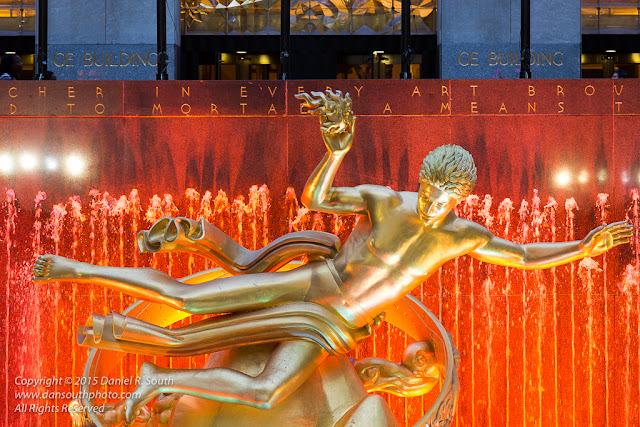Photographers use a variety of terms to describe their lenses, and those terms are sometimes confusing.
Most people understand that a wide-angle lens can be used to "fit" a large space or object into the frame. But wide-angle lenses can have a profound effect on the appearance of small objects as well.
Move in close to a small object with a wide-angle lens, and its size will be magnified with respect to the objects behind it. This effect is known as perspective distortion.
 |
| Perspective Distortion - Wide-Angle Lens (24mm) - Near Objects Appear Larger |
We can use perspective distortion creatively, but it requires the photographer to exercise caution in some cases. If you photograph someone's face with a wide-angle lens, for instance, their nose will look huge.
Factoid: The mirrors on the side of your car are effectively wide-angle lenses. This is why they come with the disclaimer that "objects may be closer than they appear."
On the other side of the spectrum, we have telephoto lenses. Using a telephoto lens, we can fill the frame with a distant subject, effectively isolating it from neighboring objects that might cause distraction in the composition.
Some people mistakenly refer to telephoto lenses as "zoom" lenses, i.e. lenses that let them "zoom in" on the distant subject. Some lenses do feature both "zoom" and telephoto capabilities.
The important distinction is that zoom lenses can vary their focal length continuously. The photographer can zoom from wide-angle to telephoto, or from short telephoto to long telephoto.
But many telephoto lenses - especially those used by professionals (at sporting events, for instance) - have no zoom capability. They are built to provide a single telephoto perspective. They still magnify and isolate distant subjects, but the magnification is not variable.
 |
| Distant Subject Isolated With A Telephoto Lens (183mm) |
Between the expansive distortion of wide-angle lenses and the isolating compression of telephoto sits an unassuming and poorly understood lens called the "normal" lens.
Normal lenses are so named because they produce the "normal" perspective of the human eye.
This description confused me when I began to study photography. Human beings see a wide angle of view, much wider than somewhat cropped angle of view of the normal lens. But "normal perspective" doesn't describe angle of view. I describes the relationship of near to far objects.
The flower photo above demonstrates the perspective distortion of wide-angle lenses. Notice how small the next flower pot looks (right side of the photo) compared to the frame-filling size of the flowers that are directly in front of the camera.
When we take a photo with a normal lens, distant objects aren't miniaturized so dramatically. The natural perspective of our eyes is maintained.
 |
| Across The Street - The Perspective of the Normal Lens |
In the photo of two motor scooters parked across the street from one other, the red scooter is about as far away as the second flower pot in the wide-angle flower photo. Notice that it's size is not reduced to the same degree.
(The only distortion that we notice is the blurring of the distant cycle, a creative option chosen at the time of exposure. With a different aperture setting or focus stacking, both scooters could easily have been rendered in focus.)
Some photographers avoid the normal lens. They prefer the drama of wide-angle lenses or the isolating compression of telephoto lenses. The normal lens is popular in documentary photography where realistic perspectives are valued, as well as in fine art photography, where shooters look for expressive ways of rendering their subjects.
Images captured with a normal lens stand out in part because of the LACK of a dramatic perspective. With a normal lens, photographs have the option to frame their subjects in a clear, unadorned way that communicates directly and simply without reliance on special effects.
Cameras: Canon EOS 5D Mark II, Nikon D810
Lenses: Various
Wishing you great light and meaningful moments!
Copyright 2015 Daniel R. South
All Rights Reserved
No comments:
Post a Comment